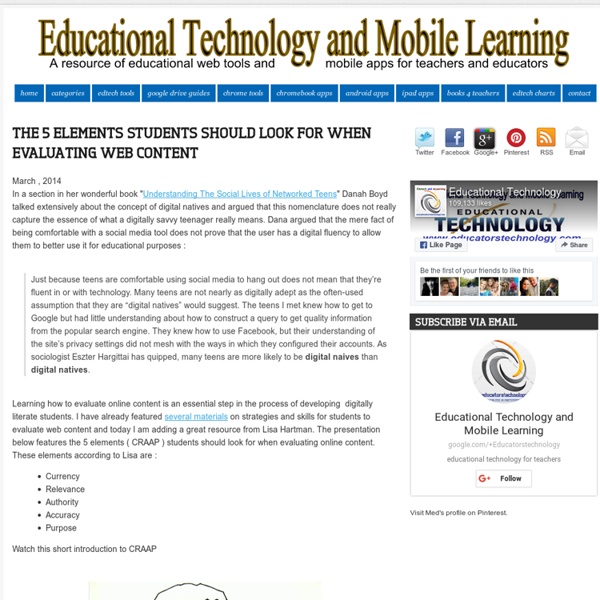Checklist for Evaluating Web Resources | USM Libraries | University of Southern Maine
Is the Web a good research tool? This question is dependent on the researcher's objective. As in traditional print resources one must use a method of critical analysis to determine its value. Authority: Is the information reliable? Check the author's credentials and affiliation. Does the resource have a reputable organization or expert behind it? Are the sources of information stated? Can the author be contacted for clarification? Check for organizational or author biases. Scope: Is the material at this site useful, unique, accurate or is it derivative, repetitious, or doubtful? Is the information available in other formats? Is the purpose of the resource clearly stated? What items are included in the resource? Is the information factual or opinion? Does the site contain original information or simply links? How frequently is the resource updated? Does the site have clear and obvious pointers to new content? Format and Presentation: Is the information easy to get to? Cost and Accessibility:
It's Fake???
There are four broad categories of fake news, according to media professor Melissa Zimdars of Merrimack College. CATEGORY 1: Fake, false, or regularly misleading websites that are shared on Facebook and social media. Some of these websites may rely on “outrage” by using distorted headlines and decontextualized or dubious information in order to generate likes, shares, and profits. CATEGORY 2: Websites that may circulate misleading and/or potentially unreliable information CATEGORY 3: Websites which sometimes use clickbait-y headlines and social media descriptions CATEGORY 4: Satire/comedy sites, which can offer important critical commentary on politics and society, but have the potential to be shared as actual/literal news
E.S.C.A.P.E. Junk News
GRADE LEVEL: Middle and high school TIME: 30-60 minutes MATERIALS: E.S.C.A.P.E. Junk News poster (download), E.S.C.A.P.E.: Six Key Concepts worksheets (download), a news story for students to evaluate, internet access Make copies of the E.S.C.A.P.E.
Wonderopolis | Where the Wonders of Learning Never Cease
Keep it REAL–4 Easy Steps to Determine Source Credibility | College Ready
The problem: Not all sources are created equal. The solution: Keep it REAL–4 Easy Steps to credible & authentic source material. When it comes time to do research, most of us (not *just our students), reach for our phones and just “Google it.” Yet, when it comes time to incorporate source content into their writing, we want students to go beyond that one easy step. Our students have an enormous amount of information at their fingertips. As we know though, all internet sources are NOT created equal. The four quick and easy steps are: Read the URL. Use an in-class discussion to educate students on the importance of each of these four categories, using the chart as a guide while you talk. There are other approaches to this question of source credibility. So, when it comes to source credibility, let’s help our students keep it REAL. Like this: Like Loading... Author: lisa I'm a college English instructor, passionate about education.
Is This Story Share-Worthy? Flowchart - NewseumED
GRADE LEVEL: Middle and high school TIME: 30-60 minutes MATERIALS: Is This Story Share-Worthy? flowchart, either printed on large paper or available to view on a screen(s) (download); Is This Story Share-Worthy? worksheet, one per group (download); news stories for students to evaluate (at least one per group); internet access Review the Is This Story Share-Worthy?
Digital Citizenship
Digital Citizenship - Main Page
Archived: Effects of Technology on Classrooms and Students
A r c h i v e d I n f o r m a t i o n Change inStudent andTeacherRoles When students are using technology as a tool or a support for communicating with others, they are in an active role rather than the passive role of recipient of information transmitted by a teacher, textbook, or broadcast. The student is actively making choices about how to generate, obtain, manipulate, or display information. Technology use allows many more students to be actively thinking about information, making choices, and executing skills than is typical in teacher-led lessons. The teacher's role changes as well. Project-based work (such as the City Building Project and the Student-Run Manufacturing Company) and cooperative learning approaches prompt this change in roles, whether technology is used or not. IncreasedMotivation andSelfEsteem The most common--and in fact, nearly universal--teacher-reported effect on students was an increase in motivation. The kids that don't necessarily star can become the stars.
Using Technology In The Classroom
Technology has always been a major focus on EducationWorld.com. This archive compiles many of the features we have done on the subject of using technology in the classroom. Many of these articles have been updated many times or even rewritten as technology changes. That said, due to the ever-changing nature of technology, there will be articles on this list that are a little past their prime period of usefullness. Social Networking Tips for Teachers Social networking in the classroom? Teaching? Fifth Graders Soar in the Blogosphere Across the curriculum, Gillian Ryan asks her fifth graders to respond in writing to the topics they discuss -- whether in math, science, social studies, or language arts -- and their ideas become posts to classroom blogs. Podcasts Promote Reading Librarian Malissia Bell has challenged students to create 500 podcasts describing their favorite books. Who Is They? Not All Who Twitter Are Twits The concept behind Twitter is simple. Who's Talking Online? Quick!
Journey in Technology
to teach. to learn. to empower. this is my world. — nashworld



